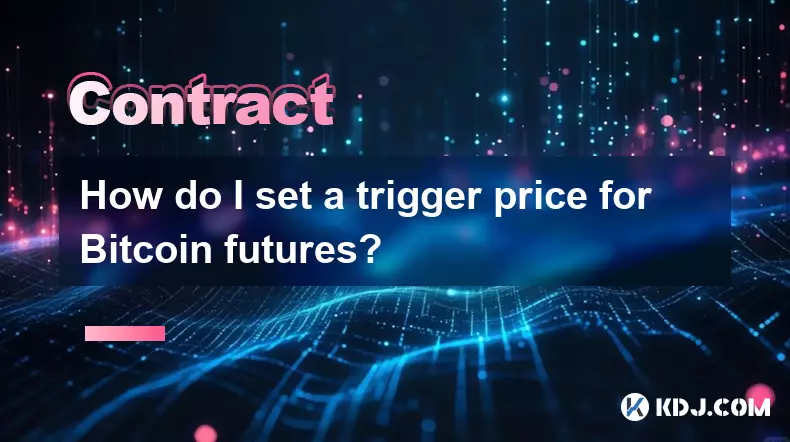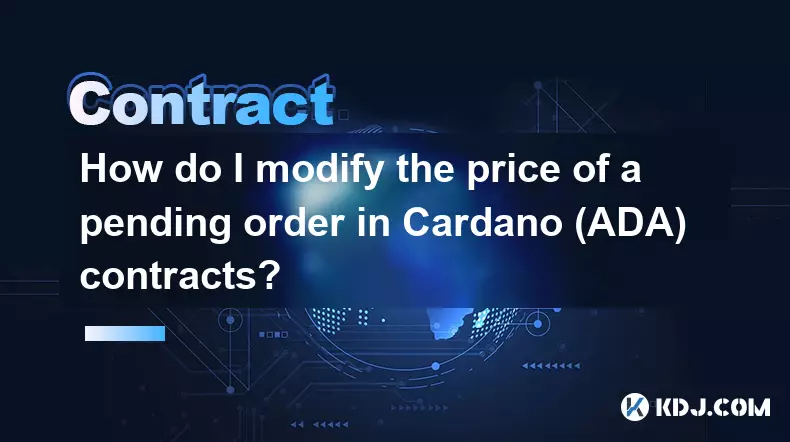-
 bitcoin
bitcoin $109667.069529 USD
-3.03% -
 ethereum
ethereum $3936.685804 USD
-4.07% -
 tether
tether $1.000493 USD
0.01% -
 xrp
xrp $2.771823 USD
-4.74% -
 bnb
bnb $957.805027 USD
-5.34% -
 solana
solana $196.735100 USD
-6.68% -
 usd-coin
usd-coin $0.999727 USD
-0.01% -
 dogecoin
dogecoin $0.227355 USD
-5.12% -
 tron
tron $0.335205 USD
-0.81% -
 cardano
cardano $0.779256 USD
-3.59% -
 ethena-usde
ethena-usde $0.999900 USD
-0.06% -
 hyperliquid
hyperliquid $42.492095 USD
-6.61% -
 chainlink
chainlink $20.501853 USD
-4.34% -
 avalanche
avalanche $28.952606 USD
-11.21% -
 stellar
stellar $0.356038 USD
-3.93%
How do I set a trigger price for Bitcoin futures?
A trigger price in Bitcoin futures activates stop or limit orders when the market hits a preset level, helping traders manage risk and automate exits.
Sep 23, 2025 at 01:00 pm

Understanding Trigger Prices in Bitcoin Futures
1. A trigger price in Bitcoin futures acts as a conditional parameter that activates a specific order type when the market reaches a predetermined level. This mechanism is commonly used with stop-limit or stop-market orders to manage risk or secure profits. Traders set a trigger price based on technical indicators, support and resistance levels, or anticipated volatility events.
2. The trigger price does not execute the trade directly. Instead, it serves as the threshold that prompts the exchange to place the associated order into the order book. For example, if a trader holds a long position and sets a stop-market order with a trigger price below the current market value, the system will issue a market sell order once that price is hit.
3. Accuracy in setting the trigger price is crucial. Placing it too close to the current market price may result in premature execution due to minor price fluctuations. Conversely, setting it too far away could lead to larger-than-expected losses. Monitoring historical volatility and order book depth helps refine this decision.
Selecting the Right Order Type
1. Stop-market orders use a trigger price to activate a market order. Once the trigger price is reached, the system sells or buys at the best available price. This guarantees execution but not price, which can be risky during flash crashes or sudden spikes.
2. Stop-limit orders also rely on a trigger price but execute as a limit order once activated. This gives more control over the execution price but introduces the risk of non-execution if liquidity dries up after triggering.
3. Trailing stop orders adjust the trigger price dynamically based on price movement. They maintain a set distance from the highest price for long positions (or lowest for shorts), offering flexibility during trending markets without requiring manual updates.
4. Some advanced platforms offer guaranteed stop orders, where the exchange ensures execution at the exact trigger price, often for a fee. These are useful in highly volatile conditions but are not universally available across exchanges.
Platform-Specific Configuration Steps
1. On most cryptocurrency derivatives exchanges like Binance, Bybit, or OKX, traders access the futures trading interface and select the contract they wish to trade. Within the order panel, there is typically an option labeled “Stop-Limit,” “Stop-Market,” or “Trigger Order.”
2. After selecting the order type, users input the trigger price, which must be clearly distinguished from the execution price in stop-limit scenarios. Mistaking these values can lead to unintended outcomes.
3. The platform may require confirmation of leverage, position size, and margin mode before allowing submission. Some interfaces include a visual chart tool to set the trigger price by dragging a marker to a specific candle or level.
4. Before finalizing, traders should review the estimated liquidation price and potential slippage. Reputable platforms display simulated impact based on current market depth, helping avoid unexpected exposure.
Risks and Common Pitfalls
1. False triggers occur when the price briefly touches the trigger level due to wicks or low-liquidity trades but quickly reverses. Exchanges using mark price instead of last traded price can mitigate this by filtering out anomalous data points.
2. Slippage is a major concern with stop-market orders during high volatility. A trigger price may activate a sell order, but the actual fill price could be significantly worse, especially in illiquid contracts.
3. Network latency or API delays can cause discrepancies between intended and actual trigger activation. Using reliable connections and colocated servers reduces this risk for algorithmic traders.
4. Over-reliance on automated triggers without monitoring broader market context—such as macroeconomic news or whale movements—can lead to suboptimal outcomes even with technically correct setups.
Frequently Asked Questions
What is the difference between trigger price and execution price?The trigger price initiates the order, while the execution price is where the trade actually fills. In stop-limit orders, these can differ significantly if the market gaps past the limit price after triggering.
Can I change the trigger price after placing the order?Yes, most platforms allow modification or cancellation of unexecuted trigger orders. However, this depends on the exchange’s interface and whether the order has already been activated by market movement.
Why didn’t my stop-limit order execute after the trigger price was hit?This usually happens when the market moved past the trigger level but did not reach the specified limit price, or there was insufficient liquidity at that price. The order remains pending until conditions match or it is canceled.
Do all futures contracts support trigger orders?Most major perpetual and quarterly futures contracts on leading exchanges support trigger-based orders. However, availability may vary for less popular pairs or niche derivatives products.
Disclaimer:info@kdj.com
The information provided is not trading advice. kdj.com does not assume any responsibility for any investments made based on the information provided in this article. Cryptocurrencies are highly volatile and it is highly recommended that you invest with caution after thorough research!
If you believe that the content used on this website infringes your copyright, please contact us immediately (info@kdj.com) and we will delete it promptly.
- AlphaTON's Bold Bet: Toncoin, Balance Sheets, and the Future of Digital Treasuries
- 2025-09-27 04:45:15
- Crypto Kidnapping in Minnesota: A New York Minute Breakdown of the $8 Million Heist
- 2025-09-27 04:25:14
- Avalanche, RUVI, and the Altcoin Rush: What's Fueling the Fire?
- 2025-09-27 04:25:14
- Ripple's RLUSD Takes Center Stage: Bybit Listing and Derivatives Market Potential
- 2025-09-27 05:05:12
- Bitcoin, Ethereum, and ETF Outflows: What's Shakin' in Crypto?
- 2025-09-27 05:25:13
- Worldcoin's WLD: Support Rebound or Further Decline? A New Yorker's Take
- 2025-09-27 05:05:12
Related knowledge

How do I enable the "scalping-only" mode for Cardano (ADA) contracts?
Sep 24,2025 at 03:19am
Understanding Scalping Strategies in Crypto Derivatives1. Scalping in cryptocurrency trading refers to executing multiple short-term trades within min...

What is the maximum position limit for Cardano (ADA) contracts?
Sep 23,2025 at 11:00pm
Understanding ADA Futures and Derivatives Market Structure1. Cardano (ADA) futures contracts are offered by several major cryptocurrency derivatives e...

What is the maker fee for Cardano (ADA) contracts?
Sep 26,2025 at 09:01am
Understanding Maker Fees in Cardano (ADA) Contracts1. The concept of maker fees applies broadly across decentralized exchanges and smart contract plat...

How can I view open interest in Cardano (ADA) contracts?
Sep 24,2025 at 07:36am
Understanding Open Interest in Cardano Derivatives1. Open interest refers to the total number of outstanding derivative contracts, such as futures or ...

How do I modify the price of a pending order in Cardano (ADA) contracts?
Sep 27,2025 at 01:00am
Understanding Pending Orders in Cardano Smart Contracts1. Cardano operates on a proof-of-stake blockchain that supports smart contracts through its Pl...

What is the function of the insurance fund in Cardano (ADA) contracts?
Sep 24,2025 at 02:18am
Understanding the Role of Insurance Funds in Cardano Smart Contracts1. The insurance fund within Cardano's ecosystem is not a native feature directly ...

How do I enable the "scalping-only" mode for Cardano (ADA) contracts?
Sep 24,2025 at 03:19am
Understanding Scalping Strategies in Crypto Derivatives1. Scalping in cryptocurrency trading refers to executing multiple short-term trades within min...

What is the maximum position limit for Cardano (ADA) contracts?
Sep 23,2025 at 11:00pm
Understanding ADA Futures and Derivatives Market Structure1. Cardano (ADA) futures contracts are offered by several major cryptocurrency derivatives e...

What is the maker fee for Cardano (ADA) contracts?
Sep 26,2025 at 09:01am
Understanding Maker Fees in Cardano (ADA) Contracts1. The concept of maker fees applies broadly across decentralized exchanges and smart contract plat...

How can I view open interest in Cardano (ADA) contracts?
Sep 24,2025 at 07:36am
Understanding Open Interest in Cardano Derivatives1. Open interest refers to the total number of outstanding derivative contracts, such as futures or ...

How do I modify the price of a pending order in Cardano (ADA) contracts?
Sep 27,2025 at 01:00am
Understanding Pending Orders in Cardano Smart Contracts1. Cardano operates on a proof-of-stake blockchain that supports smart contracts through its Pl...

What is the function of the insurance fund in Cardano (ADA) contracts?
Sep 24,2025 at 02:18am
Understanding the Role of Insurance Funds in Cardano Smart Contracts1. The insurance fund within Cardano's ecosystem is not a native feature directly ...
See all articles










































































